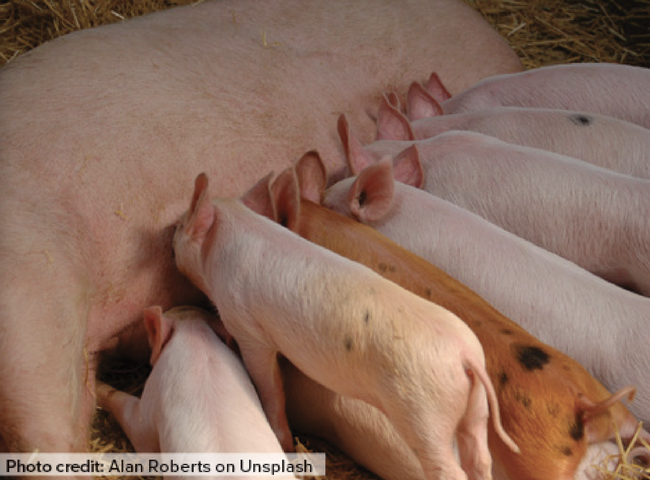Posts Tagged: Foundation
Foundation created to energize community support for UC ANR mission
Board of Directors to promote philanthropy through advocacy and fundraising in support of agriculture, natural resources and community health
The new University of California Agriculture and Natural Resources Foundation has been established to advance UC ANR's essential research and extension mission.
The foundation – to be incorporated as a 501(c)(3) organization following approval by UC President Michael Drake in October – will support programs that promote California's agriculture and food systems; natural ecosystems and working landscapes; and healthy and thriving communities.
“The establishment of this foundation could not have come at a better time, as it will inspire the vital resources and energy we need to meet the pressing challenges we pinpointed in our recently released Strategic Vision 2040,” said Glenda Humiston, UC vice president for agriculture and natural resources.
Modeled after similar entities at UC campuses, the UC ANR Foundation will be guided by a volunteer Board of Directors. Representing a variety of regions and communities across California, the directors collectively bring years of experience in the agriculture, natural resources, government, academic and nonprofit sectors.
“By tapping into the board's connections, relationships and knowledge of our work and its impact, UC ANR is well-positioned to undertake significant and truly transformative fundraising initiatives and campaigns,” said Greg Gibbs, executive director of UC ANR Development Services.
The Board currently comprises eight community leaders and three ex officio members:
Don Bransford
Owner and Operator
Bransford Farms
Tom Delfino
Sr. Principal
S.S. Papadopulos & Associates
Bill Frost
UC Cooperative Extension Advisor Emeritus and former Associate Vice President
UC ANR
Anne Haddix
Co-President, Board of Directors
UC Master Gardeners of Sonoma County (Volunteer)
Corinne Martinez, Board Chair
President and Chief Operations Officer
Berryessa Gap Vineyards
Soapy Mulholland
Principal
Sopac & Associates LLC
Sharon Nance
President
NTAPROBLM LLC Inc.
Stephen Reid
Head Gardener of the Rose Garden
The Huntington Library and Botanic Gardens
Ex Officio Members
Greg Gibbs, Board Secretary
Executive Director, Development Services
UC ANR
Glenda Humiston
Vice President
UC ANR
Tu Tran, Board Treasurer
Associate Vice President
UC ANR
“We are grateful to the members of the new board for their leadership, expertise and passion for our mission, and we're thankful to the many donors – past, present and future – who generously support our work to improve lives all across California,” Humiston said.
History of philanthropic support empowered creation of foundation
It has been that outpouring of support – channeled by Gibbs' fundraising team – that enabled the establishment of the UC ANR Foundation. Gibbs was part of a nascent development team created just seven years ago, in 2017, to increase private funding from individuals, foundations, companies and agricultural commodities groups.
Within that time, the Development Services team has raised crucial funds for a wide range of impactful programs and projects. For example, philanthropic support is fueling efforts to cultivate workforce development in agriculture and related fields in Orange County, drive innovations in the “circular bioeconomy” within the San Joaquin Valley, strengthen wildfire resiliency in communities across the foothills of the Sierra Nevada, and propel leading-edge research to benefit growers of citrus, grapes and other valuable commodities.
“People are seeing the true impact of UC ANR, and I think this foundation board is a testament to that,” Gibbs said. “It's a validation of all the work that's been done over the last seven years.”
In 2023, a Vice President's Cabinet began laying the groundwork for the foundation by establishing its bylaws and structure. That group comprised several current board members, as well as Andrea Ambrose, UC ANR director of advancement; Adina Merenlender, professor of Cooperative Extension in conservation science; and Kerry Tucker, chief strategic counsel at Nuffer, Smith, Tucker.
Then, presented with UC ANR's track record of robust fundraising and measurable impacts, UC President Drake approved the incorporation of the new nonprofit foundation on Oct. 2. The foundation will begin work with UC ANR leadership and staff in early 2025 to develop short- and long-term fundraising plans.
For the public, there is an immediate opportunity to support UC ANR's work – Giving Tuesday. From midnight to midnight on Tuesday, Dec. 3, visit give.ucanr.edu to donate and participate in a global online giving event.
“Just as UC ANR programs significantly improve lives in California and across the nation and world, our donors substantively improve those programs,” Gibbs said. “They believe in what we do, and they make our research and extension activities better in every sense – more impactful, more accessible and more sustainable.”
For more information on the UC ANR Foundation and opportunities to contribute, contact Greg Gibbs at glgibbs@ucanr.edu.
Extreme weather accelerates nitrate pollution in groundwater
Extreme weather spurred by climate change, including droughts and heavy rains, may increase the risk of nitrates from fertilizers ending up in groundwater, according to a recent study from researchers at the University of California, Davis. The study found heavy rains after a drought caused nitrates to seep 33 feet under farm fields in as little as 10 days. The study was published in Water Resources Research.
“The conventional wisdom was that it could take several weeks to years for nitrates to move from the crop root zones to reach groundwater,” said corresponding author Isaya Kisekka, a professor in the Departments of Land, Air and Water Resources and Biological and Agricultural Engineering. “We found these extreme events, such as California's atmospheric rivers, are going to move nitrate more quickly.”
In this study, different methods were used to measure how much nitrate, a component of nitrogen fertilizer, was seeping down through the soil in a tomato and cucumber crop near Esparto, California. Scientists conducted their research from 2021 until 2023 when California was experiencing periods of drought followed by atmospheric rivers. They measured nitrate during both the growing seasons and the rainy seasons.
Drought can leave more nitrogen in soil
Previous studies have shown about 40% of nitrogen fertilizer used for vegetables isn't absorbed by the plants but remains in the soil. During droughts, crops don't use nitrogen efficiently, leading to excess nitrogen in the soil. This study found that if a drought is then followed by heavy rainfall, that sudden burst of water causes nitrate to seep in groundwater more quickly. The nitrate concentration in the shallow groundwater exceeded the U.S. Environmental Protection Agency maximum contaminant level of 10 milligrams per liter for drinking water.
“In California, we often say we swing between droughts and floods,” said Kisekka. “These extreme events that come with climate change are going to make the risk of these chemicals ending up in our drinking water much more severe.”
Groundwater is the primary source of drinking water for most of California's Central Valley. In some regions, such as the Tulare Lake Basin, nearly one-third of drinking and irrigation wells exceed the EPA's safe nitrate level. High nitrate levels in drinking water can increase health risks, especially for young children. It may also increase the risk of colorectal cancer.
Need for real-time soil nitrate monitoring
Central Valley farmers are required to report to the Regional Water Board how much nitrogen they applied to their field and how much was removed as part of the crop's yield. The study compared different ways of monitoring when nitrate from fertilizers seep into groundwater. Kisekka said the results highlight the need for affordable, real-time soil nitrate monitoring tools to help farmers manage fertilizer use efficiently.
By using conservation practices that limit leftover nitrates in the crop's root zone after harvest, farmers can help reduce nitrate contamination in groundwater.
This study's data will also help improve a model called SWAT, which is used to track nitrate seepage into groundwater across California's Central Valley. This effort is part of the Central Valley Water Board's program to regulate irrigated farmlands.
Other UC Davis authors include Iael Raij Hoffman, Thomas Harter and Helen Dahlke.
The study was supported by the USDA Natural Resource Conservation Service through its Conservation Effects Assessment Project. The national project is designed to assess the effectiveness of conservation practices across different watersheds. The study also had support from the USDA National Institute of Food and Agriculture.
Lawn-pocalypse! Surviving Drought
Ah, summer! The season of sunburns, pool parties, and… lawn droughts. If your once lush, green carpet now looks like a crunchy brown doormat, you're not alone. Let's dive into why your yard is staging a dramatic death scene and what you can do to...

Bermuda grass and weeds overtaking drought stressed turf grass.
A U.S.-China trade war would cost California farmers
Loss of China's preferred trade status could hurt crop, dairy and livestock exports
The Biden administration recently announced large, increased tariff rates for Chinese electric vehicles, solar cells, semiconductors, and aluminum and steel products. This raises the possibility of another trade war with China that could impact agriculture.
Economists from UC Davis and North Dakota State University evaluated the potential implications of the U.S. revoking China's Permanent Normal Trade Relations (PNTR) status. They found that if China retaliated against a change in China's PNTR status, it could lead to a 9.5% increase in China's agricultural import tariffs, resulting in potential trade losses to California agriculture of around $1 billion annually.
California agriculture was hit hard by the 2018-19 trade war with China, and many industries have still not recovered from its effects. Despite this, there is increasing support in Congress for further restrictions on trade with China, with proponents asserting that China is not complying with the World Trade Organization's regulations.
The authors' research suggests that some product groups – such as horticultural products, dairy, livestock and meats – would likely experience even steeper than average increases in import tariffs.
“The impact on import tariffs for non-agricultural sectors would be even larger, with the average import tariff going up from 3.9% to 32.5%,” said co-author of the study Colin A. Carter, Distinguished Professor in the Department of Agricultural and Resource Economics at UC Davis.
For all California agricultural exports, they estimated an average decline in export value between 28.4% and 34.8% when comparing a scenario where China's PNTR status is revoked to one where it is not. This translates into an estimated trade loss of between $800 million and $1 billion, using 2023 California agricultural exports. Some crops that rely heavily on China for exports, such as tree nuts, would be more severely impacted by these effects, particularly considering that some of them are still subjected to residual tariffs from the 2018-19 trade war.
The last trade war between the United States and China led to significant decreases in crop prices and lost export opportunities. As co-author Sandro Steinbach, Associate Professor in the Department of Agribusiness and Applied Economics and the Director of the Center for Agricultural Policy and Trade Studies at North Dakota State University notes, “Once access to a market is lost, gaining it back is difficult, as the 2018-19 trade war has shown.”
To learn more about the potential implications of the United States revoking China's preferred trade status, read the full article by Carter and Steinbach: “Revoking China's Preferred Trade Status Would Be Costly for California Agriculture,” ARE Update 27(4): 1–4. UC Giannini Foundation of Agricultural Economics, online at https://giannini.ucop.edu/filer/file/1715033514/20982/.
ARE Update is a bimonthly magazine published by the Giannini Foundation of Agricultural Economics to educate policymakers and agribusiness professionals about new research or analysis of important topics in agricultural and resource economics. Articles are written by Giannini Foundation members, including University of California faculty and Cooperative Extension specialists in agricultural and resource economics, and university graduate students. Learn more about the Giannini Foundation and its publications at https://giannini.ucop.edu/.
Pork prices may reflect uncertainty around Prop 12
California's farm animal welfare act, approved in 2018, fully implemented in January 2024 after delays
Since being passed by California voters in 2018, Proposition 12, a farm animal welfare law, has faced a series of legal challenges that have led to uncertainty and delays in the implementation and enforcement of its requirements for the treatment of breeding pigs. A new Special Issue of ARE Update sheds light on its contentious path to eventual full implementation on Jan. 1, 2024, and analyzes how these delays have affected the retail and wholesale pork market.
Preliminary data suggest that Prop 12, and the uncertainty surrounding it, have led to an average retail price increase of 20% for covered pork products (i.e., those included under the regulation, mainly uncooked cuts of pork), as well as significantly higher prices for wholesale pork products during the implementation period and as hog farms nationally continue to adjust to the law.
Prop 12, officially known as the “Prevention of Cruelty to Farm Animals Act,” was approved by 63% of California voters. The law requires housing standards for egg-laying hens, veal calves and breeding pigs for the eggs or meat of these animals or their offspring to be sold in California.
While these standards first went into effect for egg-laying hens and veal calves as early as Jan. 1, 2020, many farms and businesses were hesitant to make large investments in the sow housing and traceability requirements until legal issues were settled for Prop 12-compliant pork.
On May 11, 2023, the U.S. Supreme Court upheld Prop 12. As a result, and consistent with rulings of the Sacramento Superior Court in California, California began requiring Prop 12-compliant pork on July 1, 2023, while allowing remaining non-compliant pork already in the supply chain to be sold until Jan. 1, 2024. Although full enforcement began almost eight months after the Supreme Court ruling, hog farms, almost all of which are outside California, continue to expand the supply of pork from hogs born of mother pigs that meet California housing and treatment standards.
“A long complicated process is not uncommon for major regulations,” said Daniel A. Sumner, a study co-author and distinguished professor in the UC Davis Department of Agricultural and Resource Economics.
Economists Hannah Hawkins, Shawn Arita and Seth Meyer with the U.S. Department of Agriculture's Office of the Chief Economist have been documenting prices and quantities of hogs and pork as the industry has adjusted to Prop 12. Using Circana retail scanner data, they found that in the past nine months covered pork products sold in California increased in price compared to the rest of the United States. While there was significant price fluctuation between the partial and full implementation dates, the initial price impacts were higher than would be expected after full adjustment, with price increases of 16% for bacon and 41% for pork loin.
Based on USDA Agricultural Marketing Service data, the authors found that wholesale prices for compliant pork cuts also increased substantially during the adjustment period, with an average price premium of 22%. Due to the many delays in implementation, Prop 12-compliant pork volumes are not yet sufficient to meet quantities that would have been demanded without these significant price increases. As the industry catches up to supply sufficient quantities of compliant pork meat to meet the California demand and a new market equilibrium is reached, both retail and wholesale prices may settle at lower price premiums. However, we may still be several months away from understanding the full impact of Prop 12 on meat and egg producers and consumers.
To learn more about the implementation of Prop 12 and its impact on the retail and wholesale pork market, read the full Special Issue of ARE Update 27(3), UC Giannini Foundation of Agricultural Economics, online at https://giannini.ucop.edu/filer/file/1710543749/20936/.
ARE Update is a bimonthly magazine published by the Giannini Foundation of Agricultural Economics to educate policymakers and agribusiness professionals about new research or analysis of important topics in agricultural and resource economics. Articles are written by Giannini Foundation members, including University of California faculty and Cooperative Extension specialists in agricultural and resource economics, and university graduate students. Learn more about the Giannini Foundation and its publications at https://giannini.ucop.edu/.






